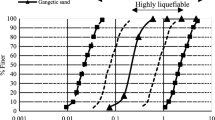Abstract
The paper pertains to the study of steady state or residual strength of sandy soils (Yamuna sand lying in the Indo-Gangetic alluvial plains) by consolidated rebounded drained triaxial test with volume change measurements and strain-controlled consolidated undrained test as well. The observed behavior obtained from these two tests is then compared to check their comparative merit. The same was also compared with those of Ganga and Toyoura sand, and with the predicted behavior obtained by using a semi empirical model. The results obtained from rebounded drained and undrained tests are found to be in good agreement. The curvature of ultimate steady state line of Yamuna sand is similar in trend to Ganga and Toyoura sand in the initial mean effective principle stress range; but the experimental observations with reference to Yamuna sand is not in good agreement with the model predictions in the region of higher mean normal stress. A semi empirical general model has been developed fitting the data for better prediction of the steady state behavior.

























Similar content being viewed by others
Abbreviations
- (Dr)c :
-
Relative Density after consolidation (dimensionless)
- Cc :
-
Coefficient of curvature (dimensionless)
- Cu :
-
Uniformity coefficient (dimensionless)
- D50 :
-
Mean grain size (mm)
- dI :
-
Intermediate particle dimension (mm)
- dL :
-
Longest particle dimension (mm)
- Dro :
-
Relative density of the steady state line, in percentage (dimensionless)
- Drs :
-
Relative density at the steady state line expressed as a ratio (dimensionless)
- dS :
-
Shortest particle dimension (mm)
- e:
-
Void ratio (dimensionless)
- emax :
-
Maximum void ratio (dimensionless)
- emin :
-
Minimum void ratio (dimensionless)
- G:
-
Specific gravity (dimensionless)
- p′:
-
Effective mean stress (kPa)
- λ:
-
Slope of the steady state line (dimensionless)
- \( \mathop \sigma \nolimits_3^\prime \) :
-
Effective confining pressure after rebound (kPa)
- σ3c :
-
Consolidation pressure (kPa)
References
Been K, Jefferies MG (1985) A state parameter for sands. Geotechnique 35(2):99–112
Castro G (1969) Liquefaction of sands. Harvard Soil Mechanics Series, Cambridge, Massachusetts, p 81
Castro G, Poulos SJ (1977) Factors affecting liquefaction and cyclic mobility. J Geotech Eng Div, ASCE 103(GT6):501–516
Cubrinovski M, Ishihara K (1999) Empirical correlation between SPT N-value and relative density for sandy soils. Soils Found 39(5):61–71
Cubrinovski M, Ishihara K (2000) Flow potential of sandy soils with different grain compositions. Soils Found 40(4):103–119
Datta A (2005) Steady state strength behavior of Ganga sand. M.Tech. thesis, Department of Civil Engineering, Indian Institute of Technology Kanpur, India
DeGregorio VB (1990) Loading systems, sample preparation, and liquefaction. J Geotech Eng, ASCE 116(5):805–821
Fear CE, Robertson PK (1995) Reconsideration of initiation of liquefaction in sandy soils. J Geotech Eng Div, ASCE 121(GT3):249–261
Konrad JM (1990a) Minimum undrained strength of two sands. J Geotech Eng, ASCE 116(6):932–947
Konrad JM (1990b) Minimum undrained strength versus steady state strength of sands. J Geotech Eng, ASCE 116(6):948–963
Lambe TW, Whitman RV (1969) Soil Mechanics. John Wiley & Sons, Inc
Mulilis JP, Seed HB, Chan CK, Mitchell JK, Arulanandan K (1977) Effects of sample preparation on sand liquefaction. J Geotech Eng Div, ASCE 103(GT2):91–108
Negussey D, Wijewickreme K, Vaid Y (1988) Constant-volume friction angle of granular materials. Can Geotech J 25:50–55
Norris G, Siddharthan R, Zafir Z, Madhu R (1997) Liquefaction and residual strength of sands from drained triaxial tests. J Geotech Geoenviron Eng, ASCE 123(3):220–228
Oda M, Koishikawa I, Higuchi T (1978) Experimental study of anisotropic shear strength of sand by plane strain test. Soils Found 18(1):25–38
Pitman TD, Robertson PK, Sego DC (1994) Influence of fines on the collapse of loose sands. Can Geotech J 31:728–739
Poulos SJ (1981) The steady state of deformation. J Geotech Eng Div, ASCE 107(GT5):553–562
Poulos SJ, Castro G, France JW (1985) Liquefaction evaluation procedure. J Geotech Eng, ASCE 111(6):772–792
Rahim A (1989) Effect of morphology and mineralogy on compressibility of sands. PhD. thesis, Department of Civil Engineering, Indian Institute of Technology Kanpur, India
Sladen JA, D’Hollander RD, Krahn J (1985) The liquefaction of sands, a collapse surface approach. Can Geotech J 22(4):564–578
Vaid YP, Chern JC (1985) Cyclic and monotonous undrained response of saturated sands, advances in the art of testing soils under cyclic conditions. ASCE Convention, ASCE, New York 120–147
Verdugo R, Ishihara K (1996) The steady state of sandy soils. Soils Found 36(2):81–91
Wadell HA (1932) Volume, shape and roundness of rock particles. Am J Geol 40:443–451
Yoshimine M, Ishihara K (1998) Flow potential of sand during liquefaction. Soils Found 38(3):187–196
Author information
Authors and Affiliations
Corresponding author
Rights and permissions
About this article
Cite this article
Sourav De, Basudhar, P.K. Steady State Strength Behavior of Yamuna Sand. Geotech Geol Eng 26, 237–250 (2008). https://doi.org/10.1007/s10706-007-9160-5
Received:
Accepted:
Published:
Issue Date:
DOI: https://doi.org/10.1007/s10706-007-9160-5




